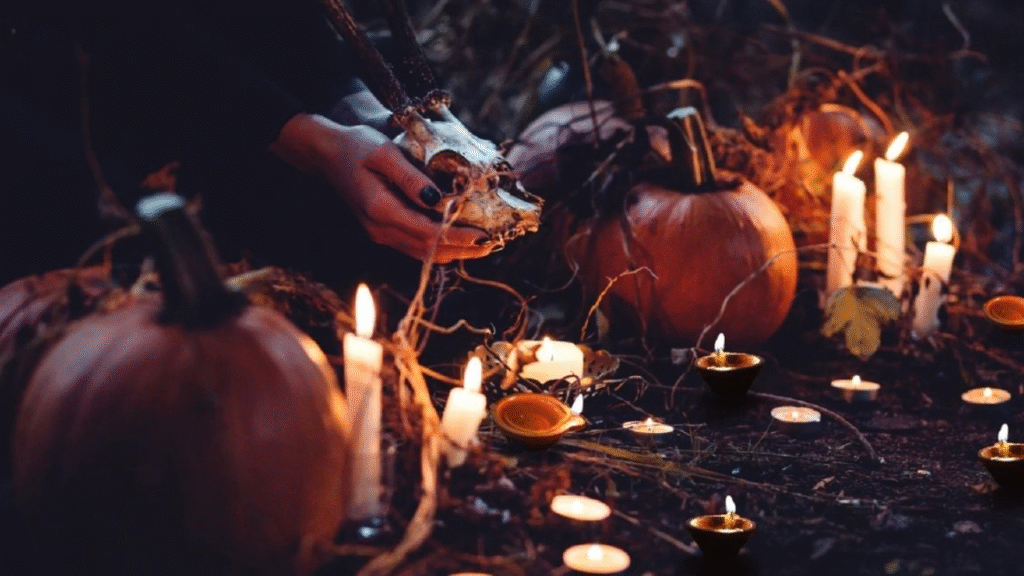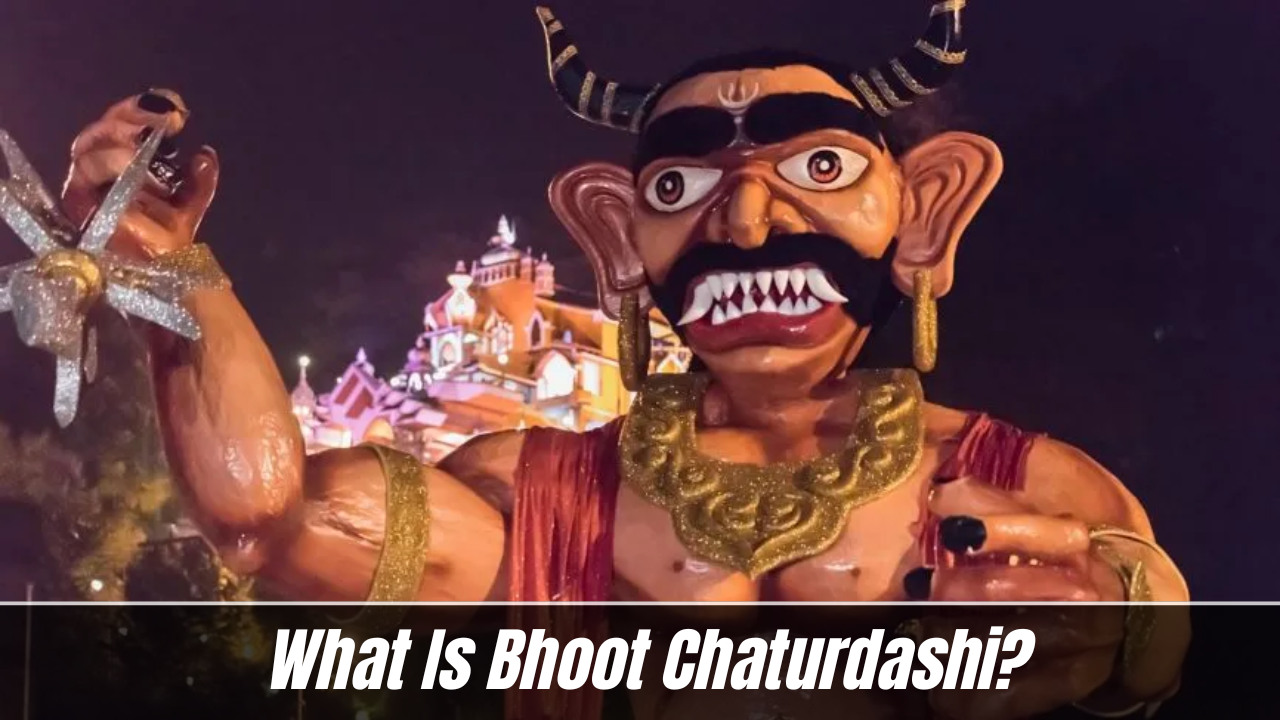Introduction
In the mystical lands of Bengal, where folklore runs deep and ancestral connections are sacred, there exists a festival like no other—Bhoot Chaturdashi. Celebrated on the eve of Kali Puja and Diwali, this ancient ritual pays homage not only to the goddess Kali but also to the spirits of the departed.
While most Indian festivals focus on deities, lights, and joy, Bhoot Chaturdashi embraces the ethereal and the eerie, blending reverence with mysticism. Its name translates to “the fourteenth night of spirits,” and it is a time when the veils between the living and the dead are said to be thinnest.
This article explores the origins, rituals, spiritual significance, cultural practices, food, superstitions, and modern interpretations of this unique Bengali festival.
1. Etymology and Timing
- Bhoot: Ghost or spirit (ancestral, not demonic in this context).
- Chaturdashi: The 14th day of the waning moon (Krishna Paksha) in the Bengali month of Kartik (October–November).
Bhoot Chaturdashi falls a day before Kali Puja, and two days before Diwali. It is closely aligned with Naraka Chaturdashi celebrated in other parts of India.
2. The Mythological Backdrop
The roots of Bhoot Chaturdashi intertwine with Hindu cosmology, Shakta beliefs, and local Bengali legends.
Key Legends:
- Goddess Kali’s Awakening: It is believed that Bhoot Chaturdashi is the night when Kali’s ferocious energy begins to stir, paving the way for her full manifestation during Kali Puja.
- Descent of Spirits: The spirits of 14 generations of ancestors are believed to visit the mortal realm on this night. They are neither malevolent nor demonic, but rather protective souls needing remembrance and honor.
- Ghostly Procession (Bhoot-Yatra): According to folklore, spirits roam freely, and only light and devotion keep them from mischief.

3. Rituals and Practices
a. 14 Diyas (Oil Lamps)
Families light 14 earthen diyas in various corners of the home, especially near doors, windows, staircases, and dark corners.
Significance:
- To illuminate the path for ancestral spirits.
- To ward off evil spirits or lost souls that may wander.
b. 14 Types of Leafy Greens
A traditional meal includes 14 types of saag (green leafy vegetables) consumed during dinner on this night.
Purpose:
- According to Ayurveda, these greens help purify the digestive system after the monsoon.
- Symbolically, it is believed they ward off evil spirits, as ghosts are said to dislike bitter, pungent flavors.
c. Avoiding Shadows and Mirrors
- Mirrors are covered, as they are believed to be portals to the spirit realm.
- People avoid casting shadows, especially while lighting diyas, since spirits are believed to dwell in darkness and reflections.
d. Staying Awake Till Midnight
It is customary to stay awake till Kali Puja begins, reciting prayers, telling ghost stories, and meditating to connect with ancestors.
4. Cultural Aspects Unique to Bengal
Bhoot Chaturdashi is deeply woven into Bengali folklore and customs, and while similar to All Souls’ Day or Halloween in concept, it carries its own spiritual gravitas.
a. Ghost Stories (Bhooter Golpo)
Families and children gather to share traditional ghost stories:
- Petni (female spirits)
- Shakchunni (married female ghosts)
- Mechho Bhoot (ghosts who love fish)
- Brahmadaitya (ghost of a Brahmin)
- Nishi (spirits who call people by name at night)
These tales have been passed down generations and often serve as moral allegories or community cautionary tales.
b. Ancestral Offerings
- Pind daan, or food offerings, are made in some rural areas.
- Temples and homes sometimes perform ancestral puja with lamps and incense.
c. Ghost-Themed Cuisine
Traditional Bhoot Chaturdashi meals include:
- Chaturdashi Shaag (mix of 14 leafy greens)
- Rice and lentils
- Light curries and ghonto (mishmash of vegetables)
- No onion or garlic, keeping meals sattvic
5. Psychological and Spiritual Symbolism
Bhoot Chaturdashi is not a celebration of fear but of recognition:
- Of death as a natural part of life.
- Of the ancestral lineage that shapes our identity.
- Of the shadow self — the unknown and ignored parts of our psyche.
6. Bhoot Chaturdashi vs. Halloween
| Feature | Bhoot Chaturdashi | Halloween |
|---|---|---|
| Origin | Hindu, Bengali tradition | Pagan roots (Celtic Samhain) |
| Timing | Day before Kali Puja | October 31 |
| Main Theme | Honoring ancestors, warding off spirits | Trick-or-treating, spooky costumes |
| Rituals | 14 diyas, saag meal, ancestral reverence | Costumes, pumpkins, haunted houses |
| Spirits | Ancestral, protective, not evil | Ghosts, ghouls, horror themes |

7. Modern Interpretations
In urban Bengal, Bhoot Chaturdashi has seen:
- Fusion celebrations with Halloween-like themes in schools and clubs.
- Spiritual workshops, storytelling nights, and community feasts.
- Social media celebrations where people post #BhootChaturdashi photos of lamps and meals.
8. Scientific and Seasonal Significance
- Eating greens boosts immunity as winter approaches.
- Lighting lamps helps combat darkness and dampness post-monsoon.
- Staying awake encourages community bonding and mental preparedness before Kali Puja.
9. Superstitions and Taboos
- Whistling after dark is avoided — it’s believed to invite spirits.
- Do not answer if someone calls your name at night — it might be a Nishi Bhoot.
- Avoid sleeping with feet facing the door.
While many of these are traditional warnings, they stem from symbolic interpretations of safety and respect for the unknown.
10. Bhoot Chaturdashi in Literature and Film
- Satyajit Ray, Bibhutibhushan Bandyopadhyay, and Leela Majumdar have all included references to Bhoot Chaturdashi in ghost stories.
- Bengali horror cinema often stages ghostly climaxes during Chaturdashi nights.
It has become a literary trope, evoking not horror but haunting beauty and mystery.
Conclusion
Bhoot Chaturdashi is more than a ghost festival—it is a celebration of ancestral connection, spiritual mindfulness, seasonal awareness, and cultural storytelling.
Amidst the glowing diyas and rustling leaves, Bengalis find a unique space to honor the past, embrace the unknown, and prepare for the divine arrival of Kali. In a world rushing toward the modern, Bhoot Chaturdashi reminds us of our roots, our rituals, and the whispers of those who came before.
Table: Key Facts of Bhoot Chaturdashi
| Aspect | Details |
|---|---|
| Name Meaning | Bhoot = spirit; Chaturdashi = 14th lunar day |
| Month Celebrated | Kartik (October–November) |
| Ritual Highlight | Lighting 14 diyas and eating 14 types of saag |
| Spiritual Focus | Honoring ancestors and warding off malevolent spirits |
| Linked Festival | Kali Puja (celebrated the next night) |
| Cultural Practice | Ghost stories, covering mirrors, staying awake |
5 FAQs About Bhoot Chaturdashi
1. Is Bhoot Chaturdashi the same as Diwali?
No. Bhoot Chaturdashi is celebrated a day before Kali Puja and Diwali, and focuses more on ancestral spirits and traditional rituals.
2. Why are 14 diyas lit?
They represent 14 ancestors, guiding their spirits home and illuminating the darkness to ward off malevolent energies.
3. What are the 14 saags eaten during Bhoot Chaturdashi?
There’s no fixed list, but commonly used greens include:
Palong, Lau shak, Pui shak, Thankuni, Kolmi, Methi, Notey, Kumro shak, Sajna pata, Neem pata, etc.
4. Is Bhoot Chaturdashi still relevant today?
Yes, especially in Bengal. It is an important spiritual and cultural event that connects people to their roots, promotes eco-consciousness, and honors ancestors.
5. Is it similar to Halloween?
They share a common theme of spirits and timing but differ in intent, ritual structure, and cultural origin. Bhoot Chaturdashi is about ancestral reverence, not horror or costumes.
